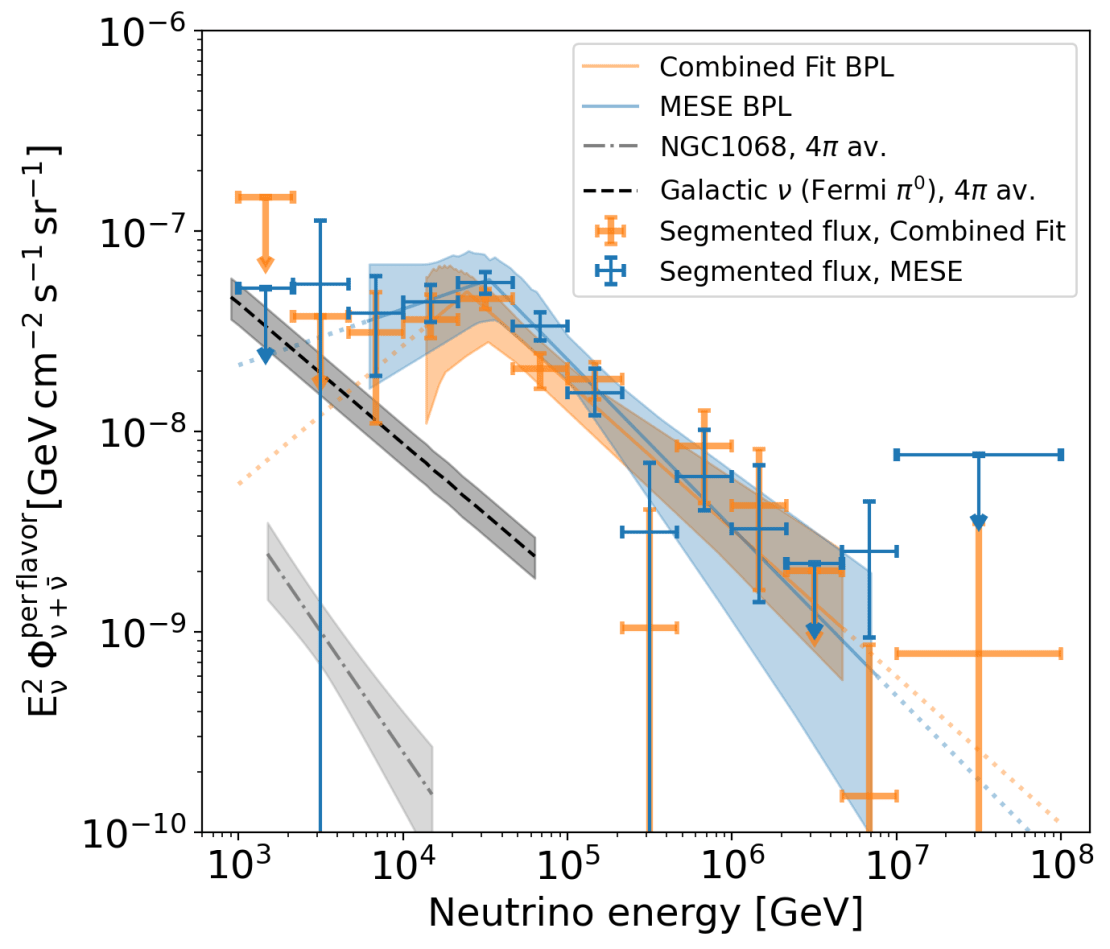The IceCube Neutrino Observatory, embedded in a cubic kilometer of Antarctic ice, searches for weakly interacting particles called neutrinos that are able to travel undisturbed through the cosmos. Of interest are high-energy astrophysical neutrinos that can arise from cosmic ray interactions with matter or photons in astrophysical sources. Thus far, the dominant sources of the astrophysical neutrino flux still elude researchers.
The total energy spectrum of astrophysical neutrinos reflects the summed contribution from all sources in the universe and is therefore expected to constitute a rather smooth distribution. Any feature in this smooth distribution is highly interesting because it may signal a significant change of the type of sources or collective changes of the dynamics within the contributing sources. Because the diffuse neutrino background encompasses all neutrino emission in the universe, it might also harbor evidence of neutrinos produced by new and unknown physics, such as the decay or annihilation of dark matter particles.
The IceCube Collaboration reports two complementary analyses of 10 years of data, sensitive to neutrino events from 1 TeV to 10 PeV, in a joint submission to Physical Review Letters and Physical Review D. Both analyses found consistent results about the shape of the extragalactic diffuse neutrino spectrum. For the first time, a significant deviation of the spectrum from a simple smooth power law is identified. The researchers found a feature—like a break or curvature—in the spectrum at around 30 TeV. This observed feature indicates a smaller neutrino flux towards smaller energies than a simple extrapolation of previous measurements and thus potentially resolves a tension that has been pointed out in recent years about the intensities of the extragalactic neutrino and gamma-ray backgrounds.







The main analyzers of the study were Aswathi Balagopal V., a postdoctoral researcher at the University of Delaware; Vedant Basu, a postdoctoral researcher at the University of Utah; Richard Naab, a recent DESY PhD graduate; Erik Ganster, a recent RWTH Aachen University PhD graduate; and Zelong Zhang, a recent Stony Brook University PhD graduate.
For one of the analyses, the researchers utilized a new event sample that consisted of medium-energy starting events (MESE), which allowed them to study the astrophysical neutrino flux with energies all the way down to 1 TeV. The other analysis combined existing data samples of tracks and cascades (a “combined fit”) for a more precise measurement. The MESE sample builds upon a previous IceCube analysis using a sample of high-energy starting events (HESE), where “starting events” are neutrinos that interact within the instrumented volume of IceCube, which allowed measuring the cosmic neutrino spectrum above 60 TeV.
“We extended the concept of HESE to lower energies in order to understand the shape of the spectrum across several energy scales,” says Balagopal V.
“We found that at 33 TeV, the spectrum of cosmic neutrinos deviates from a simple power law, following a steeply falling ‘soft’ spectrum above this energy and a less steep, or ‘harder,’ spectrum below this energy for both analyses,” says Basu. “This result has great implications for the mechanisms of neutrino production at their sources, theorized to be sites where cosmic rays are accelerated to very high energies.”
Although the majority of astrophysical sources still remain to be resolved, this result will undoubtedly improve efforts to model neutrino production in order to obtain a consistent picture of the high-energy universe.
“IceCube has already recorded considerably more data than included in the datasets used for this study, and it continues to do so,” says Markus Ackermann, a senior staff scientist at DESY. “The deployment of the IceCube Upgrade later this year will give us new calibration devices in the ice that will further reduce systematic uncertainties, such as the optical properties of the glacial ice, that currently limit the precision of the measurements.”
+ info “Evidence for a Spectral Break or Curvature in the Spectrum of Astrophysical Neutrinos from 5 TeV–10 PeV,” IceCube Collaboration: R. Abbasi et al. Submitted to Physical Review Letters. arxiv.org/abs/2507.22233 and “Improved measurements of the TeV- PeV extragalactic neutrino spectrum from joint analyses of IceCube tracks and cascades,” IceCube Collaboration: R. Abbasi et al. Submitted to Physical Review D. arxiv.org/abs/2507.22234